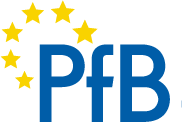Façade testing
Façades represent the face of a building and characterise the first impression of its architecture. The complex structure of a façade must not only protect against the effects of the weather, but also optimise the energy balance. Façades offer protection from wind, rain and temperature fluctuations, and thus have a significant influence on the energy efficiency of a building. Due to their close connection with the technical equipment, they are essential for sustainable construction.
It is often unavoidable that tests are necessary to prove the required properties for the building project and to approve the façade for production. The strength of PfB is to realise test dates with a short lead time.
In this context, the PfB – Prüfzentrum für Bauelemente plays a decisive role by testing façades in detail under real conditions.
Properties
- sound insulation
- air permeability
- water tightness against driving rain
- resistance to windload
- burglary
- thermal insulation
- fall protection
- special tests
Extract from the tests offered by PfB
| Description | Test acc. to | Classification acc. to |
| Resistance to windload | DIN EN 12179 | DIN EN 13116 |
| Water tightness against driving rain | DIN EN 12155 | DIN EN 12154 |
| Air permeability | DIN EN 12153 | DIN EN 12152 |
| Acoustics – Laboratory measurements of sound insulation of building elements – | DIN EN ISO 10140 | |
| Acoustics – laboratory measurement of the flanking transmission of airborne and impact sound | DIN EN ISO 10848 | |
| Acoustics – rating of sound insulation in buildings and of building elements | DIN EN ISO 717-1 | |
| Acoustics – field of measurement of sound insulation in buildings and of building elements | DIN EN ISO 16283 | |
| Sound insulation in buildings | DIN 4109 |
|
| Burglary | DIN EN 1627 | |
| Thermal protection | DIN EN ISO 10077 | |
| Fall protection | DIN 18008-4 |
Fencing off external influences: The key role of façades
The PfB has optimised façade test stands measuring 6 x 8 m available for testing your façade. The air permeability, watertightness against driving rain and resistance to wind load are verified in a combined test.
Our testing institute offers a comprehensive range of tests for curtain wallings in accordance with EN 13830. These tests include specific tests for air permeability, resistance to wind load and watertightness against driving rain.
It also makes sense to test façades for sound insulation and burglary and to have thermal calculations carried out.
Air Water Wind: focus on static resistance
Air permeability: Our tests measure the amount of air that flows through the façade under certain pressurised conditions. The requirements are usually specified in a specification.
The wind load on a façade depends on various factors such as building height, position and shape. The deformation is verified in accordance with DIN EN 12179. The wind load is caused by static positive or negative air pressure. The wind load specifications are usually determined by a wind report prepared by a structural engineer.
water tightness against driving rain: The test determines the wind pressure up to which a façade resists penetrating water. The basic test is carried out with static wind pressure and can optionally be supplemented with dynamic driving rain. These tests simulate the effects of heavy rain in windy conditions.
American standards: Our institute also carries out tests according to American ASTM, AAMA standards and CWCT test sequences. This allows you to ensure that your products meet the specific requirements of the American or British market.
Sound insulation: effective solutions for quiet spaces
Another key area of PfB testing is sound insulation by testing the building acoustics of façades. In accordance with the DIN 4109 and DIN 52210 standards, we assess façades in different sound insulation classes.
- Airborne sound insulation
Rw (C; Ctr) (dB) weighted sound reduction index - Longitudinal sound insulation
Dn,f,w (C; Ctr) (dB) weighted standardised flanking sound level difference
The sound reduction measurements are determined by measurements in the test stand, whereby the test samples are installed with ideally highly sound-insulating joints in accordance with standardised specifications. The test results are given as single figure data with additional assessment using the spectrum adjustment values C (e.g. residential activities) and Ctr (e.g. traffic noise).
Further tests on façades:
Fall protection: From a fall height of 1.0 m, proof of fall protection is required for window elements and fixed glazing with a parapet that is not sufficiently high. Fall protection is regulated nationally. Fall-protection elements made of glass are regulated in DIN 18008-4.
Impact resistance: Testing is carried out in accordance with CWCT Hard and Softbody Impact or DIN EN 14019. The test simulates the impact of hard or elastically deformable objects on a façade. The assessment is based on strength and / or visual aspects.
Burglary: Not only doors and windows, but also façades are targets for burglars. When testing burglar-resistant properties, the entire building element, including the installation in the building structure, must be considered. This is a destructive test in which representative test specimens are subjected to the loads of the resistance class to be achieved.
Burglary: Not only doors and windows, but also façades are targets for burglars. When testing burglar-resistant properties, the entire building element, including the installation in the building structure, must be considered. This is a destructive test in which representative test samples are subjected to the loads of the resistance class to be achieved.
Thermal insulation:
This is an important indicator of the energy efficiency and comfort of a building. The heat transfer coefficient (U-value) is a specific characteristic value for the heat transfer through a building component. The U-value indicates the amount of heat that passes through 1 m2 of a building component at a temperature difference of 1 K. It is essentially determined by the thermal conductivity and thickness of the materials used.
Special tests: We also offer special tests that are tailored to your specific needs and requirements for your façades. Whether you want to test specific materials or simulate the effects of certain mechanical environmental conditions, we can plan test sequences to suit your requirements.
The test certificate is issued on the basis of the technical documentation and, if required, production monitoring is also carried out by the PfB certification centre. Please feel free to contact us at any time if you have any further questions about the testing of facades. We will be happy to assist you.
Ansprechpartner

Andreas Nerz
(0)8036 674947 – 0
